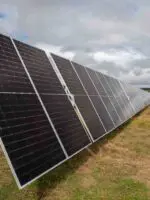As South Australia scrambles to manage its vast and still booming rooftop solar resource, it is becoming increasingly evident that solutions will be found in smart control and software, and not hard-wired rules and restrictions.
GreenSync has announced the rollout of a new model of its decentralised energy exchange, or deX, promising to deliver unprecedented visibility and control of what lies behind the meter in S.A. homes, joining a growing number of companies looking to offer digital registrations of customer-owned devices ranging from batteries and solar PV to electric vehicles in South Australia.
The solar systems or batteries are signed up to the deX platform by the installer, via an easy to use app, giving the customer the option to join existing or new virtual power plants and get more value from their investments – be they solar alone, solar and battery or – in the future – electric vehicles and electric vehicle chargers.
To this end, GreenSync has so far partnered with a raft of battery and inverter manufacturers, including Alpha ESS, Enphase, Fronius, GoodWe, Growatt, SENEC, Solar Analytics, Solax Power, Solis, Sungrow and Wattwatchers.
The South Australian platform is also being established with a handful of “foundation retail partners” which include Amber Electric, Discover Energy, Powershop and Simply Energy who will develop VPP offers designed to unlock value for services from participating, eligible technologies.
As GreenSync puts it, customers can benefit from being able to view and assess VPP offers in one place and from accessing value for services, making energy service contracting accessible and scalable across many, many products.
Retailers can benefit by operating VPPs that can access deX certified brands and products, simplified third-party licencing arrangements, and deX applications and tools to accelerate installer or technology vendor-led registration and enrolment activities.
At the other end of the spectrum – and this is where the backing of the South Australian government and its utilities comes in – the deX offers unprecedented visibility of the state’s world-leading distributed solar resource, as well as what GreenSync calls “red-button” control in the case of emergency.
That sort of control has been on the wish-list of the Australian Energy Market Operator for some time now, particularly in South Australia where rooftop solar is regularly supplying around 60 per cent of daytime demand, and recently reached a record high of 93.7 per cent of state demand and more than 70 per cent of total production.
In fact, increasingly urgent warnings from AEMO this year led South Australia to hurriedly and somewhat controversially rush through strict new standards for inverters designed to prevent large amounts of rooftop solar suddenly disconnecting as a result of voltage disturbances.
To achieve this, the government’s “Smarter Homes” program has issued a list of approved inverter suppliers and agents to ensure that new PV installations have the ability to “ride through” system faults, can be subject to changing export limits and even disconnected from the grid if needed.
GreenSync’s deX does not interfere with this process, but rather promises to make it easier and more streamlined, and to maximise the potential benefits of Smarter Homes for all parties – not least of all the wary consumer.
It’s no doubt a gratifying moment for GreenSync, which launched back in 2017 and has been working hard to carve out its place in a complex and rapidly changing Australian electricity market.
“This is a moment that we were born for,” said GreenSync chair Mark Woodall in an interview with RenewEconomy this week.
“It’s very exciting for our company because we’ve been working bloody hard on this. And I think what we’re seeing in South Australia is going to be repeated in Victoria is going to be repeated in WA. It’s going to be repeated in New South Wales. It’s not stopping in South Australia.”
Woodall likens the technology-based step-changes that are rapidly facing Australia’s rather antiquated grid to the Y2K moment, in that there was a great deal of fear of the unknown that, ultimately, was unfounded.
“We all thought the world was going to end, right? There were people sort of hunkering down in bunkers. Well, the world is not going to end in South Australia. It’s actually going to get a lot better.
“We think [the deX] makes it easier for everybody.”
The main focus in South Australia at the moment for GreenSync is building up the registry of behind the meter assets. The project aims to register at least 5,000 devices by end 2021 and will support registration from smart, controllable devices including batteries, solar PV, and EV charging technology.
“We’re integrating them as we speak,” said Woodall. “I think we’re averaging 300 people a week now just sitting on a platform in South Australia. We’ve got maybe 30 per cent of the market already of people saying, ‘Great, thank God you’re here!’
“What we’re seeing here in South Australia is start of the carrot and the stick,” Woodall added. “So all new installations now have to be registered. You might as well pick up the extra money that was lying on the table.
“In the [other Australian] markets that are purely incentive driven, the uptake will be a bit slower because there are a lot of people who don’t get round to it or don’t value it or don’t know how to value it, or whatever.
“But if it is compliance led and there’s some incentives to go with it, the take up is going to be much higher.”
And in terms of grid security and stability, consumer compliance on registration of behind-the-meter assets is going to be vital, when electric vehicle uptake starts to hit the mainstream.
“This is a brave new world and it becomes even more sort of precarious when you start to get large uptake of electric vehicles and people are suddenly randomly charging them, you know, whenever they need to,” Woodall said.
“We do a lot of work in the UK, with a major UK network, and what keeps those people up at night in screaming nightmares is EVs.
“An EV is a lot bigger than a PV system, so you don’t need many of these charging at the same time on the street to totally put that straight out of balance. And guess what, most people are going to be charging in between about 5pm and 9pm – when the sun’s gone down.”
This is not a problem yet in Australia, but it will be, and Woodall notes that governments and industry regulators and operators have the chance, now, to get ahead of the game and start planning for grid to vehicle consumption and how to manage that in a way that won’t break the system.
Nationally, Australia has lagged behind on this metric somewhat; relative to its embrace of renewable generation technology. Happily, however, state governments on both sides of the political spectrum seem to be picking up the slack.
“We congratulate GreenSync on their launch of deX in South Australia,” said the state’s energy minister, Dan van Holst Pellekaan, in a statement on Wednesday.
“This exciting project received support from our Demand Management Trials program, to help accelerate our transition to a smart, digital power system.
“By making it easier for consumers to get more value from their home batteries and electric vehicles by being part of virtual power plants, we can help support the grid whilst reducing their power bills.”










